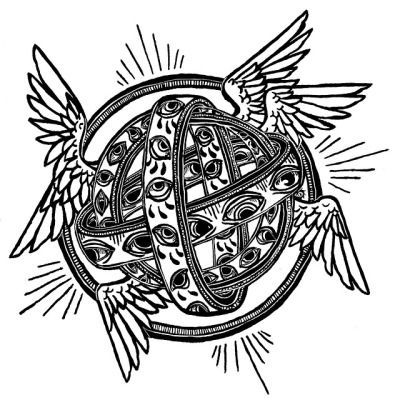What Is a Biblically Accurate Angel?

It’s always interesting to me when aspects of Christianity or stories in the Bible go viral on the internet. It’s often something outrageous or confusing, but when we approach these moments well, they can be a great opportunity to share truth with our non-Christian friends and point them toward God’s glory and power.
Most recently, I’ve seen a lot of posts about “biblically accurate angels.” Usually, they are referencing something mentioned in Ezekiel 1:15-18.
“As I looked at the living creatures, I saw a wheel on the ground beside each creature with its four faces. This was the appearance and structure of the wheels: They sparkled like topaz, and all four looked alike. Each appeared to be made like a wheel intersecting a wheel. As they moved, they would go in any one of the four directions the creatures faced; the wheels did not change direction as the creatures went. Their rims were high and awesome, and all four rims were full of eyes all around.”

This image of interlocking wheels that are covered in eyes is strange, to say the least. But is it correct to say that this is a “biblically accurate angel”?
To answer that question, we have to answer two others: first, what is this creature that Ezekiel witnesses, and second, what does the Bible say angels are like?
The Interlocking Wheels Are Called “Ophanim”
The beings that Ezekiel sees are not named in Scripture but have become known as the Ophanim, after the Hebrew words for “wheels.” This article explains that both the Dead Sea Scrolls and the non-canonical book of Enoch identify them as angels. The Christian Bible does not.
However, while the Bible does not specifically name them as angels, there is some speculation. For example, in his article, Dr. Roger Barrier explains that “the word, ‘angel,’ means ‘messenger.’” By that definition, the Ophanim may be considered angels because they were giving part of God’s divine message to Ezekiel. However, they are never specified in the Bible itself as being angels.
Annette Griffin writes that “Whether or not the Ophanim are actually angelic beings or simply a divinely powered mechanism of multidimensional transport doesn’t matter. What does matter is the Ophanim’s role in revealing God’s glory to Ezekiel and every other believer who would one day read his account and gain a fresh vision of God’s Kingship.”
In short, whether they are classified as angels or not, they are supernatural beings. The Ophanim are mind-blowing to us – certainly not something that we see in our natural world. (And to be honest, looking up artistic renditions of them is a bit unsettling.) But just because we read about something strange and unfamiliar, it does not mean that it is not true. The Bible does not exaggerate or lie, so we can be sure that the Ophanim are real. And because they are real, there is another important fact about them: they are under God’s dominion and control.
We may feel unsettled when we read something unfamiliar in Scripture, but we can rest assured that all things in Heaven and Earth are subject to God. Even the supernatural.
What Sort of Angels Do We See in the Bible?
If the Ophanim cannot definitively be called angels, then we have to ask – what does the Bible say about angels?
Merriam-Webster defines an angel as “a spiritual being serving as a divine messenger and intermediary and often as a special protector of an individual or nation.” Baker’s Dictionary clarifies that “angels were part of the divine hierarchy. They were created beings (Psalms 148:2 Psalms 148:5), and were exuberant witnesses when God brought the world into being (Job 38:7). By nature they were spiritual entities, and thus not subject to the limitations of human flesh.” The dictionary continues that there are different roles and types of angels. While “their general purpose was to declare and promote God’s will,” sometimes their purpose was to carry out destruction, to come to people in dreams, to serve as a messenger between humans and the Lord, or even as warriors.
We see angels on several occasions in Scripture, but a few examples are:
After Adam and Eve sinned, God cursed them and all of humanity and drove them out of the Garden of Eden. To keep them from returning, He placed a cherubim with a flaming sword at the gate. While this may seem harsh, it was to protect Adam and Eve (and all their descendants) from returning to the Tree of Life, and being trapped in their sinful brokenness forever.
The angel Gabriel (yes, that Gabriel) appears to Daniel twice in his dreams. In these chapters, Daniel is being given visions concerning “the end of time” (Daniel 8:17). His head (like mine) is spinning at everything he’s seeing, so Gabriel comes to explain it all. In Daniel 9, Gabriel also says that Daniel is “highly esteemed.”
In this passage we see “the angel of the LORD” blocking Balaam’s path, sword drawn. At first, Balaam doesn’t see the angel – but his donkey does. Three times, the donkey swerves out of the way of the angel, and three times Balaam angrily beats the animal. Finally, the Lord opened the donkey’s mouth, and it rebukes Balaam! As if this wasn’t enough, the angel opens Balaam’s eyes, and he sees what he’s been missing.
The gospel of Luke begins with the birth of John the Baptist. His father, Zechariah, is doing his job as a priest, burning incense at the altar of the Lord. While he is inside, an angel appears to him and tells him that his wife will bear a son. Luke tells us that Zechariah was “startled and gripped with fear” (Luke 1:12), but the angel reassures him and gives Zechariah the good news.
Shortly after, in the same chapter, an angel appears to Mary to tell her that she will bear the Messiah – Jesus. It’s notable that Mary is also a bit alarmed by the angel’s visit, even though he brings good news. We see throughout this chapter evidence that a visit from an angel was a pretty startling event; they frequently begin their messages with “fear not.”
There are other instances of angels in the Bible, but these are some of the most notable.
So What Is a “Biblically Accurate Angel”?
A biblically accurate angel is a being that appears like a man, to tell Mary that she will give birth to the Savior.
A biblically accurate angel is the seraphim, a being with six wings, crying out in praise to God with a voice so loud that it shakes the doorposts and fills the temple with smoke (Isaiah 6:2-3).
A biblically accurate angel is a humanlike figure with four faces and four wings. It has “feet like those of a calf [that] gleamed like burnished bronze.” (Ezekiel 1:7). Each of these has “the face of a human being, and on the right side each had the face of a lion, and on the left the face of an ox; each also had the face of an eagle” (Ezekiel 1:10).
A biblically accurate angel may have wings (Exodus 25:20), or they may not (Hebrews 13:2). Compelling Truth remarks that “in contrast with the popular understanding of the angels who appeared to the shepherds on the night of Christ's birth, there is no mention of wings or flying. Instead, ‘And suddenly there was with the angel a multitude of the heavenly host praising God’ (Luke 2:13). The angels may have appeared walking rather than flying.”
A biblically accurate angel is not the chubby baby with tiny wings that we often see in cartoons. Angels are not described – ever – as laying around playing the harp. A biblically accurate angel does not have a bow and arrow that they use to shoot people and make them fall in love. And the Bible never says that those we love will become angels in Heaven after they die.
To conclude, as with all things we see posted on social media, especially relating to religion and Scripture, we must do our due diligence and open the Bible for ourselves. To summarize:
Does the Bible describe beings that are interlocking wheels covered in eyes?
Yes.
Are these what all angels look like?
No.
Are they real?
Absolutely.
How can we be certain?
The Bible tells me so.
Should I be worried about being visited by a hovering, blinking wheel?
Not in the least.
Angels are fascinating to study, but it is not something that we should be overly concerned with or focused on. Finding a comfortable balance when approaching the supernatural is good for us to do. We should not be too focused on uncovering the mysteries of the supernatural; rather we can trust that all is under God’s control. But neither should we assume that none of these unimaginable things are real. This side of eternity, there will be plenty of things we just can’t fathom. But oh what a glorious day when we can see and understand it all, right alongside our Savior!
More from this author
How Do You Explain the Easter Story to Young Kids?
5 Prayers for When Everything Is Going… Right
8 Verses for When Your Patience Is Wearing Thin
Photo credit: ©Getty Images/daniele consorti
Bethany Pyle is the editor for Bible Study Tools.com and the design editor for Crosscards.com. She has a background in journalism and a degree in English from Christopher Newport University. When not editing for Salem, she enjoys good fiction and better coffee.
Originally published April 06, 2022.







